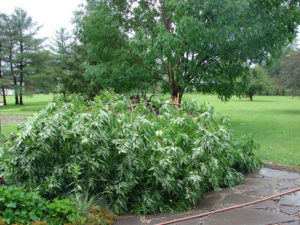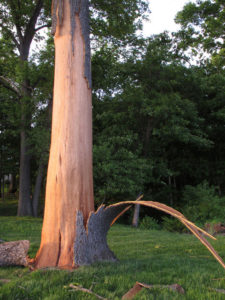When lightning strikes a tree, it will most certainly leave a calling card, but it can be difficult to predict whether that injury is strike one, two or three. There are many variables to consider, including the species, moisture content, relative health of the tree at the time of the strike, and the intensity of the strike.
Lightning can strike just about anything tall, but trees do seem to be a frequent target. And the same tree can be hit more than once. Moist tissues, which are vessels for water and carbohydrates just inside the tree bark, are better conductors of electricity than the drier wood in the center of the tree. The electrical current creates intense heating, often resulting in the bark virtually exploding off in large strips. Some trees may explode from the center of the tree, while others may have a narrow, but long, split in the trunk. If the surface of the bark is soaked with rain, the current may travel outside the trunk, resulting in less damage.
Once the storm has passed and it is safe to assess the damage, the first priority is to determine whether the tree poses a hazard to people or property. Dangling limbs, jagged branches, etc. should be removed immediately. Large limbs that cannot be safely reached from the ground call for a certified professional arborist. An arborist can also help you assess if the tree will continue to pose a hazard and should be removed.
Everybody wants to know if their tree will die from the injury. In many cases, it just cannot be accurately predicted. We’ve all seen examples of trees that live for years with extensive injury. But damaged trees will also be more susceptible to insect pests, disease, decay and environmental stress. So while they may not die immediately from a lightning strike, the damage can continue to take a toll over several months or years.
You can always take a wait and see approach, as long as the tree does not appear to pose a danger to people or property. Purdue Extension has several publications that can help you learn proper pruning techniques, as well as how to find a professional arborist.
- HO-4 Pruning Ornamental Trees and Shrubs
- Coping With Storm-Damaged Trees
- Hire An Arborist
- Trees and Storms
Check out these links, courtesy of the Purdue Plant & Pest Diagnostic Lab
- https://ag.purdue.edu/btny/ppdl/Pages/POTW2015/POTW080415.aspx
- https://ag.purdue.edu/btny/ppdl/Pages/HOT2019/HOT06022019.aspx

